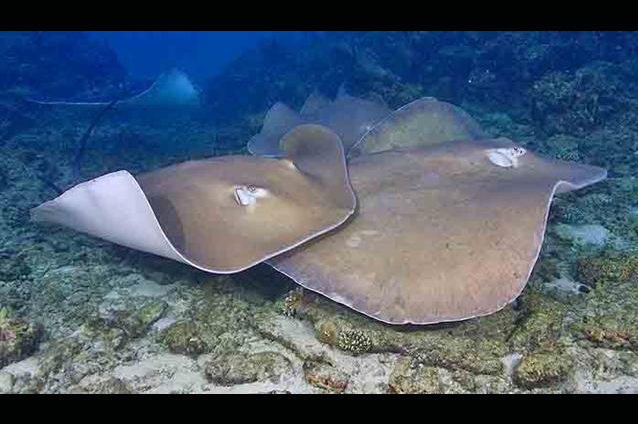Jenkins' Whipray, Pateobatis jenkinsii (Annandale 1909)
Other Names: Jenkins Whipray, Jenkin's Whipray, Rough-back Stingray

Jenkins' Whiprays, Pateobatis jenkinsii, in the Maldives, March 2009. Source: Jim Greenfield / FishBase. License: CC By Attribution-NonCommercial
Summary:
A yellowish-brown stingray with a long, whip-like tail, and a row of enlarged spear-shaped thorns and a narrow band of close-packed denticles on the disc and tail.
Video of Jenkin's Whipray
This species was previously known as Himantura jenkinsii.
Video of Jenkin's Whipray
This species was previously known as Himantura jenkinsii.
Cite this page as:
Bray, D.J. 2018, Pateobatis jenkinsii in Fishes of Australia, accessed 19 Apr 2024, https://fishesofaustralia.net.au/home/species/2027
Jenkins' Whipray, Pateobatis jenkinsii (Annandale 1909)
More Info
|
Distribution |
Ningaloo Reef, Western Australia, to the eastern Gulf of Carpentaria, Queensland. Elsewhere, the species is widespread with a patchy distribution in inshore waters of the Indo-west Pacific, from South Africa to Southeast Asia and off northern Australia. |
|
Feeding |
Presumably feeds on crustaceans and small fishes. |
|
Biology |
An ovoviviparous species (aplacental viviparous), with embryos feeding initially on yolk, then on additional nourishment from the mother by indirect absorption of uterine fluid enriched with mucus, fat or protein through specialised structures. |
|
Fisheries |
Although taken as bycatch in the Australian Northern Prawn Trawl Fishery, the introduction of Turtle Exclusion Devices (TEDs) and other exclusion devicesmay have greatly reduced bycatch of Jenkins' Whipray. |
|
Similar Species |
May be confused with the Pink Whipray, Himantura fai, which is greyish-pink and has no row of enlarged thorn-like denticles on the disc and tail. |
|
Species Citation |
Trygon jenkinsii Annandale, 1909, Mem. Indian Mus. 2(1): 28, fig. 4. Type locality: off Ganjam coast, India. |
|
Author |
Bray, D.J. 2018 |
|
Resources |
Jenkins' Whipray, Pateobatis jenkinsii (Annandale 1909)
References
Annandale, N. 1909. Report on the fishes taken by the Bengal fisheries steamer "Golden Crown." Part I, Batoidei. Memoirs of the Indian Museum 2(1): 1-60.
Dulvy, N.K. & Reynolds, J.D. 1997. Evolutionary transitions among egg-laying, live-bearing and maternal inputs in sharks and rays. Proceedings of the Royal Society of London, Series B 264: 1309–1315 DOI: 10.1098/rspb.1997.0181
Fowler, H.W. 1941. Contributions to the biology of the Philippine Archipelago and adjacent regions. The fishes of the groups Elasmobranchii, Holocephali, Isospondyli and Ostariophysi obtained by the United States Bureau of Fisheries Steamer Albatross in 1907 to 1910, chiefly in the Philippine Islands and adjacent seas. Bulletin of the United States National Museum 100(13): 1-879 figs 1-30 (as Dasyatis (Himantura) jenkinsii)
Garman, S. 1913. The Plagiostomia (sharks, skates and rays). Memoirs of the Museum of Comparative Zoology, Harvard University 36: 1-528 pls 1-77
Kuiter, R.H. 1996. Guide to Sea Fishes of Australia. A comprehensive reference for divers and fishermen. Sydney, NSW, Australia : New Holland Publishers xvii, 434 pp.
Kuiter, R.H. & Debelius, H. 1994. Southeast Asia Tropical Fish Guide. (as Himantura jenkinsii)
Last, P.R. & Compagno, L.J.V. 1999. Family Dasyatidae. pp. 1479-1505 in Carpenter, K.E. & Niem, V.H. (eds). The Living Marine Resources of the Western Central Pacific. FAO Species Identification Guide for Fisheries Purposes. Rome : FAO Vol. 3 pp. 1397-2068. (as Himantura jenkinsii)
Last, P.R., Naylor, G.J.P. & Manjaji-Matsumoto, B.M. 2016. A revised classification of the family Dasyatidae (Chondrichthyes: Myliobatiformes) based on new morphological and molecular insights. Zootaxa 4139(3): 345–368. DOI: http://dx.doi.org/10.11646/zootaxa.4139.3.2 Abstract
Last, P.R. & Stevens, J.D. 1994. Sharks and Rays of Australia. Canberra : CSIRO Australia 513 pp. 84 pls. (as Himantura jenkinsii)
Last, P.R. & Stevens, J.D. 2009. Sharks and Rays of Australia. Collingwood : CSIRO Publishing Australia 2, 550 pp. (as Himantura jenkinsii)
Manjaji, B.M. 2004. Taxonomy and phylogenetic systematic of the stingray genus Himantura (Family Dasyatidae). PhD. in Zoology Dissertation, University of Tasmania. (as Himantura jenkinsii)
Michael, S.W. 1993. Reef sharks and rays of the world. A guide to their identification, behavior and ecology. (as Himantura jenkinsii)
White, W.T., Last, P.R., Stevens, J.D., Yearsley, G.K., Fahmi & Dharmadi. 2006. Economically Important Sharks and Rays of Indonesia. Australian Centre for International Agricultural Research, Canberra, Australia.







